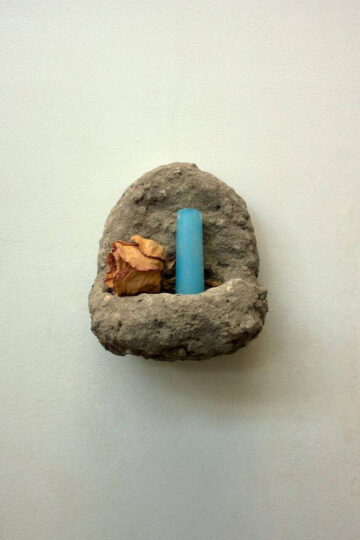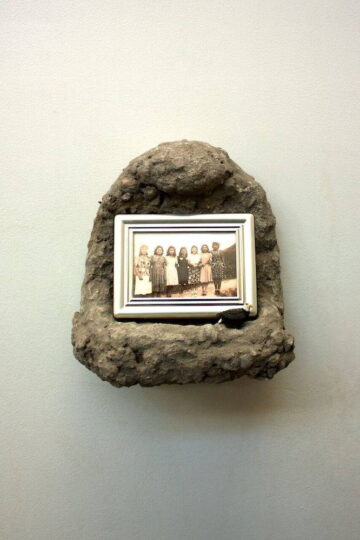The Violent Environments of the Mexico-U.S. Border

I have always been fascinated by tales of my grandfather swimming across the Rio Grande to move to the United States. As a child, I was enchanted by the symbolism of swimming into a new life. Like a natural baptismal font, the Rio Grande cleanses immigrants of their past lives, rebirthing them into new opportunities. However, this new life has always come at a cost. In 2015, an estimated 170,000 immigrants made the journey across the Mexico-U.S. border. Often carrying nothing but backpacks and water jugs, these immigrants travel on foot through the hundred-degree desert heat of Texas, New Mexico, Arizona, and California. Dehydration, exhaustion, injury, and hypothermia claim the lives of hundreds each year.
As a biracial Latina, a seventh-generation Texan of European descent on my mom’s side and granddaughter of Mexican immigrants on my dad’s, I have followed the roots of my own ancestry to shape my practice as an artist. Major events in Texas history such as the Mexican-American War, Battle of the Alamo, Treaty of Guadalupe Hidalgo, and the Bracero Program have created a complex relationship between my two cultures: Texans and Mexicans. The residual racial discord that has resulted from these historical moments—particularly, the racialization and displacement of unauthorized Latinx immigrants—is both the context and focus of my work.
Drawing on my connection to Texas land, I explore how the environmental characteristics of borderlands function within immigration control, as well as the environmental impact of what immigrants leave behind. Through printmaking, papermaking, and installation art, I encourage awareness of our current immigration and foreign affairs policies by confronting viewers with the gruesome reality that death occurs daily on the Mexico-U.S. border.
For the past two decades, the United States border patrol has practiced the strategy of “prevention through deterrence,” a policy that places more emphasis on keeping unauthorized immigrants out rather than apprehending those who have already come in. The “prevention through deterrence” model has resulted in racial profiling, an abundant use of costly resources, and a funneling of unauthorized immigrant crossings through dangerous borderland environments. Landforms such as the Sonoran and Chihuahuan Deserts, as well as portions of the Rio Grande, are left unguarded by border patrol stations to act as natural borders. This forces desperate, unauthorized immigrants to traverse these dangerous regions where many face dehydration, exhaustion, injury, hypothermia, and death.
In my screen print, Cuando la Agua Corra Seca, I imagine what it might be like to have risked everything to journey to the United States only to be met with death in the Sonoran Desert. A curtain of rosaries and a chain link fence part to expose the night sky where the face of Santo Toribio Romo Gonzalez, the Catholic patron saint of immigrants, greets me. Though many imagine death in the desert to come in the middle of the day when the sun is at its strongest, this print depicts death in the night, when the desert is cold and quiet. Peeking over the horizon, the sun brings with it the hope of seeing another day.
In 2013, more than 300 unidentified immigrant remains were discovered in the Sacred Heart Cemetery of Brooks County, Texas. Many were buried less than six feet underground in body bags, trash bags, plastic wrap, and even a milk crate. An investigation by Lieutenant Corey Lain of the Texas Rangers found “no evidence to show that human remains were buried in violation of the law.” In spite of Texas Health and Safety Code Title 8 which requires human remains to be buried in a county cemetery, placed in an impermeable container, and buried at least 18 inches underground, no criminal investigation of Elizondo Mortuary nor Brooks County was ever initiated. The story of Sacred Heart Cemetery has deeply impacted my artwork. In Asilo (Asylum), I ask, “What is considered a proper burial?” and “How are undocumented immigrant bodies treated differently from United States citizen bodies?”
To me, the failure to provide proper burial rights to these 300+ unidentified immigrants represents a clear dehumanization of undocumented Latinxs. Furthermore, the lack of criminal investigation regarding these burial practices demonstrates an unwillingness to change this system. My piece, Asilo (Asylum), named after the legal term for “the protection granted by a nation to someone who has left their native country as a political refugee,” aims to address these problems while also taking note of the use of plastic in the Brooks County immigrant graves.
The decision to bury these immigrants in plastic harms not only those who are buried in Sacred Heart’s Cemetery and their respective family members but also the land of Brooks’ County, Texas. Plastic bags are typically made of polyethylene, a man-made polymer that does not biodegrade. Some scientists estimate that polyethylene can take up to 500 years to break down, while others estimate up to 1,000 years. It is safe to assume that the plastic bags used to bury immigrants in Brooks County, Texas would have remained there for many centuries.
Since the discovery of the bodies in 2013, two universities have volunteered to process their DNA in hopes of reuniting them with their families. Though their families are sure to be grateful, they will inevitably find out that their loved ones were buried in plastic—a symbol of their perceived worth.
Unfortunately, violence against unauthorized immigrants doesn’t begin at the border. Coyotes—people paid by immigrants to bring them safely across the border—often take advantage of those they are hired to look after. Sexual assault, theft, and even murder are not uncommon for coyotes to commit. On the other side of this spectrum is the Catholic patron saint of immigrants, Santo Toribio Romo Gonzalez, whom many immigrants credit with saving their lives. It is said that Santo Toribio appears as a mirage to immigrants in need, leading them to water or nearby towns where they find refuge and work. Santo Toribio Romo Gonzalez y Los Coyotes portrays these characters meeting. The coyotes cower around Santo Toribio, who is there to protect the people they exploit.
In this screen print, Santo Toribio stands atop a mound of water jugs. The Sonoran Desert today is littered by trails of discarded water jugs, backpacks, clothing, and rosaries left by immigrants passing through. These abandoned objects are reminders of those who have made this journey before and act as a trail for future immigrants to follow. However, water jugs also symbolize the environmental toll of the United States’ immigration system.
Along with threatening human life, the funneling of unauthorized immigrants across natural borders can also threaten wildlife. Trails and roads carved by immigrants affect erosion patterns that in turn kill vegetation and disrupt animal habitats and migratory patterns, while trash and human waste left behind affect soil and water quality. The plastic water jugs littered across these landscapes are only the most visible of these environmental impacts.
Those lucky enough to make it safely across the border often become trapped in industries that take advantage of their immigration status. Of the two million farm workers employed in the United States, an estimated fifty to seventy percent are undocumented. Many pick strawberries and cotton, which are physically demanding crops to harvest due to the required bending and kneeling for extended amounts time. These physically demanding jobs often lead to exposure to pesticides, herbicides, and other agricultural chemicals. Because undocumented workers face the threat of deportation on a daily basis, they have no power to resist unfair wages. They often lack decent housing, job security, representation, and the ability to file grievances. After moving to the United States in hopes of a better life, immigrants often experience unjust work conditions with little economic freedom.
While issues at the border may not directly affect many United States citizens, the lives of undocumented immigrants are entwined in our societies. It is important to recognize the larger historical and economic influences that have forced Latinx people into immigration, as well as the contemporary political tactics that utilize borderlands as a weapon against undocumented immigrants. In my installation, Seeking Asylum, a series of cement shrines pays respect to those who have made this journey while remembering those who have died in the process.
The landscape of present-day Texas, which was once a part of Mexico, is now a dangerous place for Latinx immigrants. In effect, contemporary immigration conditions forge a mutually destructive relationship between immigrants and borderland environments.
As a biracial Latina and Tejana, I serve as an example of how these two cultures can work in harmony. Through my artwork, I hope to not only give a voice to undocumented immigrants who are silenced in fear of deportation and death, but to also inspire social and political change to end this mass displacement and loss of life.
Featured image: Santo Toribio Romo Gonzalez Prayer Card, screenprint by J. Leigh Garcia, 2016.
J. Leigh Garcia is an artist born and raised in Dallas, TX. Garcia received a BFA in printmaking from The University of North Texas and is currently pursuing an MFA at The University of Wisconsin–Madison. Website. Instagram. Contact.











Fantastic and thought provoking work! The intersections of immigration and environmental justice offer such a bounty of injustices to expose. Art is such an important medium to express these interconnections—and one that can often create a more impactful response than just words.